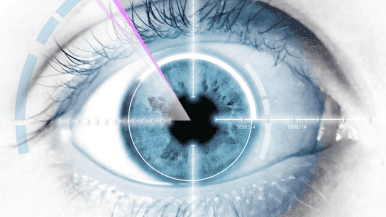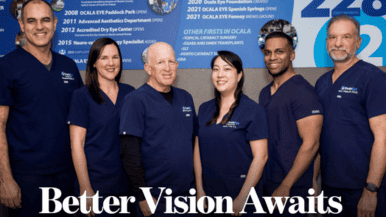We know you have questions about LASIK corrective eye surgery. That’s why Ocala Eye recently conducted a Facebook live LASIK surgery Q&A panel with some of our board-certified refractive surgeons.
Participating doctors included: Mark A. Jank, M.D.; Peter J. Polack M.D., F.A.C.S.; Hussain Elhalis, M.D.; and Vishwanath Srinagesh, M.D.. Read on to find out about exactly what to expect before, during, and after LASIK.
The Ocala Eye team is available to discuss any questions or concerns you may have about LASIK or other treatments. Please get in touch, and we’ll do what we can to help.
Dr. Polack was an early adopter of LASIK and is a strong advocate for the procedure, having had the surgery himself 20 years ago. During the Q&A, he went straight to the heart of what is a big question for many patients who are afraid to have the procedure.
Dr. Polack says, “It’s perfectly natural to be afraid to have something done to your eyes.” Even 20 years ago, Dr. Polack says the LASIK procedure was very safe and it’s “that much safer now.”
LASIK is perhaps even safer than wearing contact lenses. Dr. Polack says, “The risk to your eyes from wearing contact lenses is higher than the risk of having a laser procedure.”
Dr. Polack admits that it’s common for a person to feel nervous about any surgical procedure. “If you’re not nervous or scared about having the procedure then that makes me nervous,” he says. However, he sets patients at ease by telling them, “In my 20-year career, I have never personally seen a single vision-threatening complication from LASIK.”
Dr. Jank says LASIK is a great choice, except if you’re over age 45 when “a different set of variables comes into play.” He reports there are three areas to review for patients over 45 when considering LASIK:
- Is there a cataract?
- Is the patient’s vision changing?
- Would the patient prefer a refractive lens exchange instead?
Dr. Jank points out that before age 45, if you want to eliminate your dependence on glasses, “LASIK is your only option.” After age 45, if there is a cataract present, and it’s changing, a cataract extraction or a refractive lens exchange, may be a better option.” In both cataract extraction and refractive lens exchange, surgeons take out the old lens in your eye and replace it with a new lens. The difference is that in cataract surgery, the lens they’re replacing is cloudy instead of clear.
Dr. Jank says if you’re over 45, cataract extraction or refractive lens exchange are good options because, “you get a lot more for your money.” Compared to LASIK, there are five important benefits of refractive lens exchange when you have a cataract:
- Long-distance vision correction
- Intermediate vision correction
- Near-vision correction
- Your cataract can be removed
- Your vision quits changing
LASIK can correct your long-distance vision and possibly your intermediate vision, but not your close-up vision problems.
Dr. Elhalis says the criteria Ocala Eye uses to screen patients for LASIK surgery include:
- Making sure it’s safe for you to have LASIK
- Knowing that LASIK will give you a good health outcome and meet your goals
- Ensuring that the results from your LASIK procedure will last a long time
When you come in for your initial eye examination, Dr. Elhalis says, he looks closely at your contact lens or eyeglasses prescription to be sure it has been consistent for several years. You will also receive a thorough exam to ensure that your eyes are healthy and you don’t have any medical conditions to complicate the surgical process. Dr. Elhalis says, “If you meet all of those criteria, then you are a good candidate.”
Vishwanath Srinagesh, M.D., or Dr. Vish, as patients call him, says, “Absolutely.” There are several ways this can happen. Through a procedure called corneal Intacs, a slightly different procedure, your doctor can increase “the depth of focus in the eye.”
Alternatively, they could perform monovision. Dr. Vish says this procedure, “entails treating one eye for distance vision and treating the other eye for near vision.” Patients are then able to blend these two types of vision corrections together to improve their near vision without using reading glasses.
Dr. Polack says, “One thing to realize is that any time you have eye surgery, whether it’s LASIK, PRK, [or] cataract surgery, you can have aggravation of dry eye.” He points out that the most common complaint of patients seeking LASIK is that they no longer can comfortably wear their contact lenses. Why? That’s usually because the patient has developed dry eye syndrome.
However, Dr. Polack points out that in 95% of cases, the dry eye is just temporary. He says, “It’s important for us to identify dry eyes before the procedure and to optimize the eye before having the LASIK or PRK procedure […] to ensure we have a good postoperative outcome.”
Dr. Jank says, “LASIK basically works by changing the shape of the cornea.” Both LASIK and PRK do the same thing, by carefully incising a small flap in the front of the eye (the lens) and then using a precision laser and computerized technology to carefully reshape the inner cornea. Then the lens flap is laid back down onto the eye and it heals naturally with no stitches.
The results of the surgery last “a long time,” and the procedure is fast, painless, and safe.
Dr. Elhalis says, “The goal, of course, is to make sure you heal well.” He says the most important restriction after surgery is that you don’t rub your eyes. This allows the lens flap to stay in place and heal properly. Patients leave Ocala Eye with eye protection that they can wear during the day and night to facilitate this healing process.
Additionally, Dr. Elhalis recommends that you avoid hot tubbing or swimming for a few weeks to “avoid any kind of dirty water.” Eye makeup could potentially compromise the eye flap, so you should also avoid wearing any for a short time.
Dr. Elhalis continues, “We’ll ask you to kind of take it easy, as far as exercise—no strenuous activity.” Also make sure you’re limiting your use of electronic devices, to help reduce eye strain and drying out your eyes unnecessarily.
Dr. Vish says, “No, insurance doesn’t cover LASIK, but there are several great options for paying.” At Ocala Eye, you have a financing option with CareCredit. They allow low monthly installments with 0% interest so you can enjoy the benefits of LASIK without breaking your bank.
“It can be made very affordable for the average patient,” Dr. Vish continues. Many patients discuss how much they’re saving over time by having the LASIK procedure. He says, “The cost of contact lenses adds up.” Most patients spend about $350 annually on contact lenses and supplies and many patients have a backup set of glasses. Dr. Vish says, “Really within a couple of years you’re spending as much money as it would take to pay for your LASIK.”
Dr. Polack says, “PRK is the kind of granddad of LASIK.” PRK stands for photorefractive keratectomy and it is the precursor to laser-assisted in situ keratomileusis (LASIK). Both laser surgery techniques are safe and effective treatments to modify the cornea of the eye.
During PRK, the surgeon removes the top corneal layer called the epithelium, then uses lasers to reshape the cornea. LASIK snips a tiny envelope into the cornea, folds back the flap, reshapes the cornea, then folds the envelope shut.
Dr. Jank says, “Basically, LASIK lasts forever.” He suggests that patients will eventually age and potentially need cataract surgery, “So if you’re young, the ideal patient for LASIK is in their mid-twenties whose refraction is stable.” As these patients age into their 40s, 50s, 60s, and 70s, they develop cataracts and need surgery to correct the problem.
“Here at Ocala Eye, we’re very experienced,” Dr. Jank continues. “During [your cataract] surgery, special measurements are made to account for the fact that LASIK has been done.” He continues, “If you go to a practice that isn’t experienced in doing cataract surgery on patients who have had previous LASIK, then your odds of getting the implant focusing power correct are about 50/50.”
Dr. Elhalis reports that 98% of patients are 20/40 or better after LASIK. He reminds us that “the main goal of LASIK is to make sure that you’re really reducing your dependence on contact lenses and glasses.”
Your happiness with LASIK results can depend on your goals. Dr. Elhalis says, “Some folks really want just good up-close vision.” Others, he reports, want better distance vision. The goal of the Ocala Eye team is to give you the results that you’re looking for.
“LASIK can correct nearsightedness, farsightedness, astigmatism, and presbyopia,” Dr. Vish answers. Of course, there are a lot of conditions that LASIK can’t correct, as well.
Dr. Vish continues, “It’s important to get checked by someone that’s qualified to distinguish what LASIK can be applied for appropriately. That’s why if you’re interested in LASIK to call in and schedule a free consultation.”




